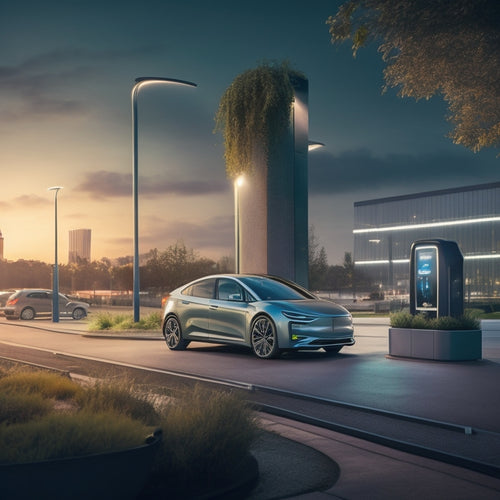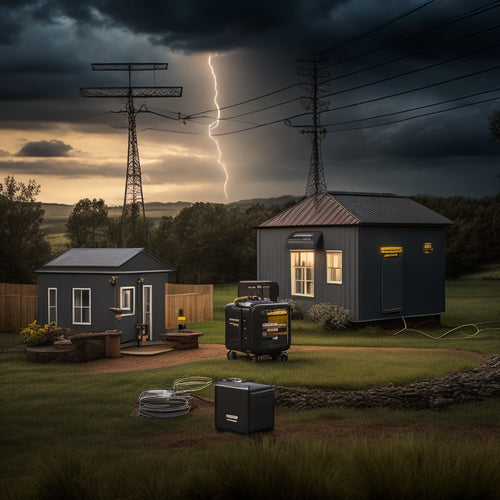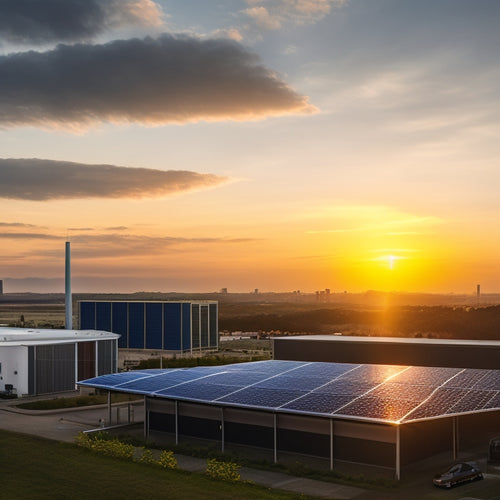
Set Up Home Power Independence Kits
Share
You're about to set up a home power independence kit, a complex system requiring careful planning and execution. First, choose a kit that matches your existing electrical infrastructure, appliances, and energy needs. Consider solar panel components, including panel efficiency, mounting systems, and inverters. Select a battery storage system that suits your energy requirements, and guarantee proper connection of the inverter and charge controller. Install mounting and tracking systems securely, and implement a monitoring system to track performance. Regular maintenance practices, such as daily checks and software updates, will assure ideal performance; now, consider the specific details that will make your kit a success.
Key Takeaways
- Assess your home's electrical infrastructure and appliances to ensure compatibility with the power independence kit.
- Choose solar panels with high efficiency ratings and suitable mounting systems for your roof or ground.
- Select a battery storage system that meets your energy needs, considering factors like type, size, and charging sources.
- Connect inverters and charge controllers correctly to ensure efficient energy conversion and flow regulation.
- Regularly monitor and maintain your system to prevent issues, optimize performance, and extend its lifespan.
Choosing the Right Kit
Your home power independence kit is a significant investment, and choosing the right one is vital to achieving your energy goals. When selecting a kit, consider kit compatibility with your existing electrical infrastructure and appliances. Confirm the kit's voltage, frequency, and power output align with your energy needs.
Effective design guarantees reliability and efficiency in energy systems, with energy storage capacity and inverter efficiency being essential for seamless power supply off-grid energy systems. Budget planning strategies are fundamental to guarantee a smooth installation process.
Determine your energy requirements, and calculate the necessary kit size and components. Research and compare prices from different manufacturers, considering factors like warranty, maintenance, and customer support.
Understanding Solar Panel Components
You'll want to familiarize yourself with the inner workings of solar panels to get the most out of your home power independence kit. This starts with understanding solar panel basics, including how photovoltaic cells convert sunlight into electricity.
When selecting panels, think about high-efficiency panels for peak energy production. Additionally, verify the structural soundness of your roof to support the installation.
From there, you'll need to reflect on panel efficiency ratings and mounting system options to guarantee peak energy production and a secure installation.
Solar Panel Basics
A solar panel's core components work in harmony to convert sunlight into electrical energy.
You'll find photovoltaic (PV) cells, which convert sunlight into DC power, and an inverter, which converts DC power into usable AC power for your home.
The PV cells are protected by a layer of glass or plastic, and the entire panel is mounted on a durable frame.
When you invest in a solar panel, you're utilizing the solar energy benefits of renewable energy, reducing your reliance on fossil fuels, and minimizing your environmental impact.
Panel Efficiency Ratings
Solar panel efficiency ratings measure how effectively a panel converts sunlight into electrical energy. You'll see these ratings listed as a percentage, typically ranging from 15% to 22%. A higher rating indicates a more efficient panel.
When comparing different panels, consider the efficiency rating in conjunction with the panel's size and power output. This will give you a better understanding of the panel's overall performance. For instance, a smaller, high-efficiency panel might outperform a larger, lower-efficiency one.
Advances in panel technology have led to improved efficiency ratings over the years, making them more viable for home power independence. When making an efficiency comparison, look for panels with high ratings and consider the specific technology used, such as monocrystalline or polycrystalline silicon.
Mounting System Options
Your solar panel system's mounting system plays a critical role in guaranteeing the panels are securely fastened to your roof or the ground, while also allowing for peak energy production.
When choosing a mounting system, you'll need to take into account fixed mounts, adjustable mounts, roof mounts, ground mounts, and pole mounts. Fixed mounts are cost-effective but don't allow for adjustments, while adjustable mounts enable seasonal tilting for ideal energy harvesting.
Roof mounts are ideal for residential installations, while ground mounts offer more flexibility. Pole mounts are suitable for larger systems.
You'll also need to think about tracking systems, which follow the sun's movement to maximize energy output. Aesthetic considerations, DIY options, and commercial solutions will impact installation costs.
Carefully weigh these factors to guarantee your mounting system meets your energy needs and budget.
Setting Up Battery Storage Systems
You'll need to choose the right battery type for your system, factoring in elements like depth of discharge, cycle life, and cost, with options ranging from lead-acid to lithium-ion batteries.
When selecting a battery system, it's crucial to evaluate key features such as capacity, round-trip efficiency, and warranty, as seen in top-rated systems like the Tesla Powerwall.
When sizing your battery storage system, you'll need to calculate your energy requirements, considering your daily energy usage, desired backup time, and available charging sources.
Battery Types Compared
Among the essential components of a home power independence kit, batteries play a significant role in storing excess energy generated by your renewable sources.
When choosing a battery type, you'll likely come across lithium-ion and lead-acid options. Lithium-ion batteries boast advantages like high energy density, long lifespan, and low maintenance requirements. However, they come at a higher cost.
Lead-acid batteries, on the other hand, are more affordable but have drawbacks like shorter lifespans, lower energy density, and slower discharge rates. Temperature effects can also impact performance, with lithium-ion batteries performing better in extreme temperatures.
Consider recycling options and installation tips when making your decision. Ultimately, a cost comparison will help you determine which battery type best suits your needs and budget.
System Sizing Essentials
To guarantee a seamless shift to home power independence, sizing your battery storage system correctly is essential.
You'll need to accurately assess your energy requirements to confirm your system can meet your power needs. This involves load forecasting, which involves analyzing your energy usage patterns to determine the maximum amount of power you'll need at any given time.
Effective energy management is also vital, as it enables you to optimize your energy usage and reduce your reliance on the grid.
Connecting Inverters and Charge Controllers
Your off-grid power system's inverter and charge controller are essential components that require proper connection to guarantee efficient and safe energy generation.
You'll need to connect your inverter, which converts DC power from your solar panels or wind turbine into AC power for your home, to your charge controller. There are different inverter types, including string inverters, microinverters, and power optimizers, each with its own connection requirements.
Your charge controller, responsible for regulating the flow of energy from your solar panels to your battery bank, must be connected accordingly to prevent overcharging or undercharging.
Make certain you understand the specific functions of your charge controller, such as maximum power point tracking and overcharge protection, to make the correct connections.
Installing Mounting and Tracking Systems
Now that you've connected your inverter and charge controller, it's time to focus on securing your renewable energy sources.
Installing a mounting system for your solar panels or wind turbine is essential for ideal energy harvesting. Make sure the system is sturdy and can withstand various environmental conditions.
Consider the weight and size of your renewable energy source when selecting a mounting system. For solar panels, tracking technology can greatly improve energy output by adjusting the panel's angle to follow the sun's movement.
Installation tips include making certain the mounting system is level and securely fastened to your roof or ground. Additionally, consider consulting local building codes and regulations before installation.
Monitoring and Maintaining Your Kit
Its monitoring system provides real-time data on your kit's performance, helping you identify potential issues before they escalate into major problems.
This allows you to take proactive measures to guarantee peak kit maintenance. Regularly review the monitoring data to detect anomalies, and address them promptly to prevent system downtime.
-
Check the system's voltage, current, and temperature readings daily to confirm they're within the recommended ranges.
-
Perform routine inspections of the physical components, such as connections, wiring, and panels, to identify signs of wear or damage.
-
Update the system's software regularly to verify you have the latest features and security patches.
-
Run diagnostic tests to identify potential issues before they become major problems.
-
Schedule regular maintenance tasks, such as cleaning the panels and inverters, to uphold peak performance.
Frequently Asked Questions
Can I Use My Kit to Power My Entire House?
You'll need to assess your energy needs and your kit's power capacity to determine if it can power your entire house; consider your average daily energy consumption, peak usage, and the kit's maximum output to guarantee a reliable and efficient supply.
Are Home Power Independence Kits Environmentally Friendly?
Like a refreshing change, you're wondering if home power independence kits are environmentally friendly. You'll be relieved to know that they offer significant sustainability benefits, utilizing renewable energy sources to reduce your carbon footprint and reliance on fossil fuels.
How Long Does It Take to Set up a Home Power Kit?
When you're about to start the installation process, you're probably wondering how long it'll take. The setup time varies, but on average, it takes around 2-5 hours for a basic system, depending on the complexity and your level of DIY proficiency.
Can I Install a Kit on a Rented Property?
Like a shipwrecked sailor on foreign shores, you're charting uncharted territory. When renting, you'll face installation restrictions; make certain you get your landlord's permission before proceeding, and carefully weigh rented property considerations to avoid any potential electrical or contractual storms.
Are Home Power Independence Kits Compatible With Grid Ties?
You're wondering if your home power system can integrate with the grid; fortunately, most kits are designed with grid tie integration in mind, ensuring seamless kit compatibility and efficient energy distribution when you need it.
Related Posts
-

Solid State Batteries in Electric Vehicles
Solid-state batteries revolutionize electric vehicles by offering a longer lifespan and higher energy density than tr...
-

Key Components of a Reliable Emergency Power Supply System
A reliable emergency power supply system requires several key components. You need proven performance metrics to guar...
-

Advantages of Commercial Solar Battery On-Site Storage
By investing in a commercial solar battery on-site storage system, you can greatly reduce your energy grid dependence...


